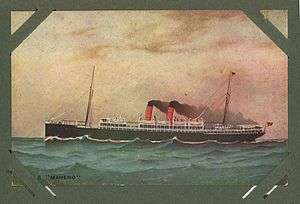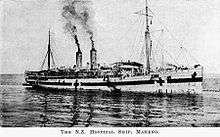SS Maheno
SS Maheno was an ocean liner belonging to the Union Company of New Zealand that operated in the Tasman Sea, crossing between New Zealand and Australia, from 1905 until 1935.
 Hand-coloured postcard of the SS Maheno | |
| History | |
|---|---|
| Name: | SS Maheno |
| Owner: | Union Company, Dunedin |
| Port of registry: | Wellington[1] |
| Route: | New Zealand — Australia |
| Builder: | William Denny and Brothers, Dumbarton |
| Yard number: | 746[1] |
| Launched: | 19 June 1905[1] |
| In service: | November 1905 |
| Out of service: | 1935 |
| Identification: | Official number: 117588[1] |
| Fate: | Wrecked, July 1935 |
| General characteristics | |
| Type: | Ocean liner |
| Tonnage: | |
| Length: | 400 ft (120 m)[1] |
| Beam: | 50 ft (15 m)[1] |
| Depth: | 31 ft (9.4 m)[1] |
| Propulsion: | |
| Speed: | 17.5 knots (32.4 km/h; 20.1 mph)[2] |
| Capacity: |
|
It was also used as a ship by the New Zealand Naval Forces during World War I; as His Majesty's New Zealand Hospital Ship No. 1. It was washed ashore on Fraser Island by a cyclone in 1935 where the disintegrating wreck remains as a popular tourist attraction.
Construction
The 5,000-ton steel-hulled ship was built by William Denny and Brothers of Dumbarton, Scotland, and launched on 19 June 1905.[1] At 400 feet in length and 50 feet in the beam, it was powered by three Parsons turbines, giving a speed of 17.5 knots. It could carry up to 420 passengers: 240 in 1st class, 120 in 2nd and 60 in 3rd, and also had a refrigerated cargo hold. Accommodation for first class passengers included a dining room, smoking room, and music room with Bechstein grand piano. The ship was lit by electricity, and was fitted with all the latest safety equipment, which included Clayton sulphur dioxide fire extinguishers.[2]
Service history
The ship entered service on 18 November 1905, and was employed on routes between Sydney and Melbourne via ports in New Zealand and Hobart, Tasmania. She also made regular voyages between Sydney and Vancouver.[2]
World War I

During World War I Maheno was converted into a hospital ship using money raised by an appeal by the Earl of Liverpool, the Governor-General. It was fitted with eight wards and two operating theatres, and had a medical team consisting of five doctors and 61 orderlies from the Army Medical Corps, a matron, thirteen nursing sisters, from the newly formed New Zealand Army Nursing Service and chaplains.[3] In accordance with Article 5[4] of the 1899 Hague Convention it was repainted white overall, with a broad green stripe along its sides, and large red crosses on the sides and funnels.[5]
HMNZHS Maheno arrived at Moudros, the naval base of the Gallipoli Campaign, on 25 August 1915, and the next day was off ANZAC Cove, loading casualties from the Battle of Hill 60. Over the next three months, it carried casualties from Gallipoli to Malta. They were cared for by members of the New Zealand Army Nursing Service including Evelyn Brooke.[6] Maheno arrived back at New Zealand on 1 January 1916 to refit, then returned to Egypt in February to collect patients for transport back to New Zealand. It then sailed to the UK, arriving at Southampton on 3 July 1916, just after the start the Battle of the Somme. Until October 1916 it operated in the English Channel, returning large numbers of wounded and sick troops from the Western Front to England.
Maheno sailed back to New Zealand in December 1916, and then made six more voyages between New Zealand and the British Isles, bringing back patients.[3] There were criticisms of the Maheno making several trips to New Zealand to refit or to transport wounded soldiers home when most could have gone in a troopship; and also that the ship has being run by the Governor (Liverpool) as "His Exc’s pet patriotic hobby." The Chief Medical Officer was William Collins on its first voyage and James Elliott on its second and third voyages. In 1915 Collins "raised hackles by denying nurses their officer status and deluding himself that he could command the ship’s commander, the master" (Captain McLean). In 1917 British Major Gretton was critical of the staff and said “he (Liverpool) puts his friends on the ship when they want soft jobs”. The ship’s nickname is “Liverpool’s yacht”. The complaint got as far as the Secretary of State for the Colonies; Liverpool said Gratton behaved like a cad.[7]
At the War's end in November 1918 Maheno was released from military service and returned to its business owner, whereupon resumed its commercial life.
Running aground on Fraser Island
.jpg)
_IGP4364.jpg)

At the end of its commercial life, on 3 July 1935 Maheno left Sydney under tow[8] by the 1,758 ton ship Oonah, a former Tasmanian Steamers Pty. Ltd. Bass Strait ferry, built in 1888, which along with the Maheno had been sold to the shipbreaker's yard Miyachi K.K.K. in Osaka, Japan.[9] The ships were linked by a 900-foot (270 m) 6.75-inch (17.1 cm) wire rope.[8]
On the afternoon of 7 July,[9] about 50 miles from the coast,[9] the towline parted in a cyclone. Attempts to re-attach the towline failed in the heavy seas, and the Maheno, with a skeleton crew of eight men aboard, drifted off and disappeared.[8] The Oonah, with it steering gear temporarily disabled, broadcast a radio message requesting assistance for Maheno, whose propellers had been removed.[10] Maheno was subsequently found on 10 July by an aircraft piloted by Keith Virtue, beached off the coast of Fraser Island.[11] The crew had set up camp onshore, waiting for the Oonah to arrive, which it did on 12 July.[12] The wreck was also the location of the marriage of Dudley Weatherley and Beatrice McLean (instead of at Townsville), at the invitation of Captain Takaka, to notes from the ship's Bechstein piano.[13]
The ship was subsequently stripped of its fittings,[14] but attempts to refloat her failed. The wreck was subsequently offered for sale, but no buyers could be found for it.[15]
Wreck
Maheno has remained at the location since, slowly corroding away. Due to the now dangerous condition of the ship access is prohibited.[16] The Australian Department of Defence lists the wreck as a site of unexploded ordnance (UXO) contamination, even though there are no records of it being used as a live firing target, or of any UXO being ever recovered from the site.[17]
See also
- SS Marama: sister ship; His Majesty's New Zealand Hospital Ship No. 2.
| Wikimedia Commons has media related to SS Maheno. |
References
- Allan, Bruce (2012). "SS Maheno". Clyde-built Ship Database. Archived from the original on 19 December 2011. Retrieved 21 November 2012.CS1 maint: unfit url (link)
- "THE MAHENO". The Argus. Melbourne. 7 November 1905. p. 6. Retrieved 15 September 2013 – via National Library of Australia.
- Elliott, J.S. (1923). "The New Zealand Hospital Ships". In Drew, H.T.B (ed.). The War Effort of New Zealand. Auckland: Whitcombe and Tombs Ltd. pp. 127–137. Archived from the original on 11 November 2012. Retrieved 21 November 2012.
- "Convention for the Adaptation to Maritime Warfare of Principles of Geneva Convention of 1864 (Article 5)". Lillian Goldman Law Library. 29 July 1899. Archived from the original on 10 August 2011. Retrieved 21 November 2012.
- "Hospital ship Maheno". Ministry for Culture and Heritage. 30 August 2012. Archived from the original on 1 November 2012. Retrieved 21 November 2012.
- "Evelyn Brooke". nzhistory.govt.nz. NZHistory. 17 May 2017. Archived from the original on 6 July 2017. Retrieved 11 July 2017.
- McLean, Gavin (2013). The White Ships: New Zealand’s First World War Hospital Ships. Wellington: New Zealand Ship and Marine Society. pp. 78–80, 141. ISBN 978-0-473-24977-9.
- "SHIPPING IN THE BIG BLOW: MAHENO MYSTERY". The Cairns Post. Cairns, Queensland. 10 July 1935. p. 7. Retrieved 21 November 2012 – via National Library of Australia.
- "SHIPS IN PERIL: ADRIFT OFF EAST COAST". Western Mail. Perth. 11 July 1935. p. 11. Retrieved 21 November 2012 – via National Library of Australia.
- "TWO STEAMERS ADRIFT IN CYCLONE". Adelaide Chronicle. 11 July 1935. p. 28. Retrieved 21 November 2012 – via National Library of Australia.
- "MAHENO LOCATED AGROUND AT FRASER ISLAND". The Morning Bulletin. Rockhampton, Queensland. 11 July 1935. p. 7. Retrieved 21 November 2012 – via National Library of Australia.
- "TERRIFYING ORDEAL ON THE MAHENO". The Courier-Mail. Brisbane. 12 July 1935. p. 13. Retrieved 21 November 2012 – via National Library of Australia.
- McLean, Gavin (2013). The White Ships: New Zealand’s First World War Hospital Ships. Wellington: New Zealand Ship and Marine Society. pp. 183–185. ISBN 978-0-473-24977-9.
- "FITTINGS OF STRANDED MAHENO". Singleton Argus. New South Wales. 19 July 1935. p. 6. Retrieved 21 November 2012 – via National Library of Australia.
- "UNWANTED SHIP". The Sydney Morning Herald. 28 March 1936. p. 17. Retrieved 21 November 2012 – via National Library of Australia.
- "Access to Maheno prohibited" (PDF). Queensland Parks and Wildlife Service. 2010. Archived (PDF) from the original on 22 December 2012. Retrieved 21 November 2012.
- "List of UXO Contamination Sites in Queensland". Department of Defence. June 2010. Retrieved 21 November 2012.